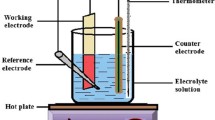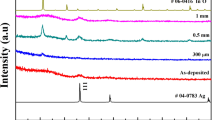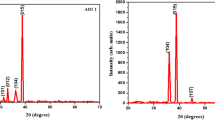Abstract
Highly transparent and conductive Al-doped ZnO/Ag/Al-doped ZnO (AZO/Ag/AZO) thin films were prepared by magnetron sputtering on glass substrates at room temperature. The effects of the addition of tiny amounts of O2 in the sputtering ambient during the AZO growth on the structural, morphological, optical and electrical properties of the films were investigated. When adding a small amount of O2 into an Ar ambient during the bottom AZO growth, the conductivity of the AZO/Ag/AZO thin films was enhanced due to the improved crystallinity of the AZO and Ag thin films and the transmittance increased with a shift of peak transmittance toward longer wavelengths. On the other hand, the transmittance decreased when both the bottom and top AZO deposited in the Ar/O2 mixed gas. The maximum figure of merit of 2.46 × 10–2 Ω−1 with 80.3% average visible transmittance and 4.17 × 10–5 Ωcm resistivity was achieved for the AZO/Ag/AZO thin film where the bottom AZO deposited under 1% O2 ambient.
Similar content being viewed by others
Explore related subjects
Discover the latest articles, news and stories from top researchers in related subjects.Avoid common mistakes on your manuscript.
1 Introduction
Indium tin oxide (ITO) with excellent opto-electrical performance is widely used as a transparent conductive electrode (TCE) for optoelectronic devices [1]. However, the indium used in ITO layers could become rare and expensive. The ceramic structure of ITO also makes it poor flexibility and induces defects when deposited on flexible substrates. Therefore, there is an urgent need to develop indium-free TCE. Recently, oxide/metal/oxide (O/M/O) TCE has attracted considerable attention owing to the high conductivity and mechanical stability [1, 2]. More importantly, the optical transmittance and reflectance of O/M/O TCE can be tuned by varying the thicknesses of the bottom and top oxide layers [3]. Ag is commonly used as the interlayer in O/M/O films due to its high visible transmittance and low resistivity [1, 2, 4]. Al-doped ZnO (AZO) is a promising oxide used as sandwich layers due to its non-toxicity, low cost and material abundance [3, 4]. As a result, AZO/Ag/AZO (AAA) thin films have been extensively studied by many researchers [1,2,3,4]. Most studies focus on the optimization of the AZO and Ag layer thicknesses in order to obtain the optimal optical and electrical properties [5,6,7,8]. Also the Ag growth parameters and their influence on the resulting sheet resistance and transmittance have been investigated [9, 10]. However, few studies have been reported on the influence of the AZO growth atmosphere on the performance of the AAA thin films.
In this paper, less amount of O2 was added into sputtering ambient during the AZO growth. The effects of the addition of O2 in the sputtering ambient during the AZO growth on the structural, morphological, optical and electrical properties of the AAA TCE were investigated.
2 Experimental details
The AAA thin films were deposited on glass substrates using a magnetron sputtering system with a background pressure below 9 × 10−4 Pa. Both the top and bottom AZO layers with thickness of approximately 40 nm were deposited using Al (2 wt.%)-doped ZnO target at a working pressure of 1.0 Pa and a RF power of 200 W. The Ar/O2 mixed gas (O2 volume ratio ranging from 0 to 4%) was introduced into the sputtering chamber during the bottom and top AZO growth. Each sample identification was denoted as AaAAb in the context, where the subscripts a and b represent the percentage of oxygen volume ratio in the sputtering ambient. The silver interlayer with the thickness of approximately 12 nm was subsequently deposited on the bottom AZO by DC sputtering with a power of 100 W and a pure Ar gas pressure of 0.6 Pa. The substrate-target distance was kept at 6 cm.
The phase structure of the thin films was analyzed by X-ray diffraction (XRD) with Cu Kα radiation in θ-2θ Bragg–Brentano geometry (Tongda, TD-3500, China). The thickness of the thin films was determined by a spectroscopic ellipsometry (Ellitop, ES03V, China). The surface morphology was examined using an atomic force microscope (AFM, CSPM5500, China). The optical properties of the thin films were measured using an UV/visible/NIR spectrophotometer (Tuopu, TP-720, China). The resistivity, carrier concentration and mobility of the thin films were measured using the Van der Pauw method by Hall measurements (Sādhudesign, SM6800, China).
3 Results and discussion
Figure 1 shows the XRD patterns of the AAA thin films deposited at different O2 ratio. The peaks at around 33° and 38° were assigned to the (002) plane of ZnO wurtzite phase and the (111) plane of the Ag phase, respectively. In A0AA0 thin film, weak peaks of Ag (111) and ZnO (002) can be observed. For AaAA0 thin film series, with increasing O2 ratio in sputtering atmosphere during the bottom AZO growth, both the AZO (002) peak intensity and the Ag (111) peak intensity increased implying an increased texture of the thin films. Moreover, the increase in the AZO (002) peak intensity was accompanied with the increase in the Ag (111) peak intensity. This suggested that the AZO (002) surface acted as a template for the textured Ag (111) film growth due to the fact that the (111) plane of a cubic structure has a similar symmetry to that of (001) plane of ZnO [3, 4]. On the other hand, the intensities of AZO (002) peak and Ag (111) peak of AaAAa thin film series increased first with the addition of 1% O2 in sputtering gas during the bottom and top AZO growth, and then, AZO (002) peak vanished and Ag (111) peak intensity decreased with a further increase in O2. The degradation of the crystalline quality for excessive O2 content was most probably caused by the negative oxygen ions bombardment [11, 12]. It is known that the bombardment of the films by high energetic negative oxygen ions in sputtering process leads to crystallographic defects by the ion peening effect [13]. In addition, adding more oxygen into the discharge might produce more neutral oxygen atoms which diffuse into films without low energy, thus creating additional unexpected defects [11].
The AFM images of the AAA thin films are shown in Fig. 2. The O2 concentration greatly affected the morphology of the AAA thin films. A small addition of O2 during the bottom AZO growth yielded larger grains and rougher surface of the AAA thin films. The RMS roughness increased from 0.69 nm (A0AA0) to 0.98 nm (A4AA0). A further increase in the RMS roughness was observed when both the bottom and top AZO deposited in Ar + O2 ambient. A4AA4 sample gave the maximum RMS roughness of 1.54 nm among all the prepared thin films.
Figure 3 shows the optical transmittance, reflectance and absorption spectra of the AAA thin film. The transmittance between around 500 and 800 nm of AaAA0 thin film series increased with increasing O2 content up to 2% during the bottom AZO growth and then decreased slightly for a further increase in O2. The improvement in transmittance mainly resulted from the reduced reflectance. When O2 was introduced into the sputtering gas during both the bottom and top AZO growth, the visible transmittance of AAA thin films decreased, and correspondingly the reflectance and absorption increased. Especially, for A4AA4 thin film, relatively large increase in the absorption was observable, which was consistent with the degradation of crystalline quality, as shown in Fig. 1. Table 1 lists the maximum transmittance, corresponding wavelength, and average visible transmittance over the wavelength range of 400–800 nm. When introducing O2 into sputtering atmosphere during the bottom AZO growth, the peak transmittance shifted from 487 nm (A0AA0) to around 550 nm (A2AA0). The shift of the peak transmittance to longer wavelengths was accompanied with the improvement in the average visible transmittance. The highest average transmittance value of 82.1% with the peak transmittance as high as 88.0% was achieved for the A2AA0 sample. It was possible that the improvement of the crystallinity of the films increased the packing density, decreased the pores at the Ag/AZO interface, and affected the effective refractive index of the films [14]. As a result, the reflectance of AAA film decreased and the corresponding transmittance increased.
The electrical properties of the AAA samples are presented in Table 1. For AaAA0 thin film series, the Hall mobility increased and the resistivity decreased when the addition of O2 in sputtering gas during the bottom AZO growth. This was ascribed to the improved crystallinity of the thin films, which reduced the interface and grain-boundary scattering [3, 15, 16]. The resistivity of the AAA thin film continued to decrease to the minimum value of 2.92 × 10–5 Ωcm when the bottom and top AZO deposited under 1% O2 ambient. With further increasing the O2 ratio above 1% during the bottom AZO and top AZO growth, the Hall mobility decreased and the resistivity increased, which was associated with the increase in the scattering of defects at the grain boundaries of the Ag film and AZO/Ag interface induced by oxygen [3, 15, 16].
To evaluate the overall performance of TCE, the figure of merit (FOM) is defined by Haacke as follows:
where T is the average transmittance in the visible range (400-800 nm) and Rs is the sheet resistance.
As shown in Table 1, the maximum FOM of 2.46 × 10-2 Ω-1 with the resistivity of 4.17 × 10-5 Ωcm and the average visible transmittance of 80.3% were achieved from the A1AA thin film when the bottom AZO deposited under 1% O2 ambient. The results indicated that highly transparent and conductive AZO/Ag/AZO thin films could be prepared by the inclusion of a remarkably small amount of oxygen, while the bottom AZO was deposited.
4 Conclusions
In summary, highly transparent and conductive AZO/Ag/AZO thin films were prepared by magnetron sputtering on glass substrate at room temperature. The addition of a small amount of O2 in an Ar atmosphere during the bottom AZO growth enhanced the conductivity of the AZO/Ag/AZO thin films due to the improved crystallinity of Ag and AZO thin films and led to a shift of peak transmittance toward longer wavelengths and higher transmittance. On the other hand, the AZO/Ag/AZO thin films were found to have decreases in transmittance when both the bottom and top AZO deposited in the Ar/O2 mixed sputtering gas. The maximum figure of merit of 2.46 × 10–2 Ω−1 with 80.3% average visible transmittance and 4.17 × 10–5 Ωcm resistivity was achieved for the AZO/Ag/AZO thin film when the bottom AZO deposited under 1% O2 ambient. This approach provides an easily realized method to fabricate high-quality indium-free transparent electrodes for the applications of optoelectronic devices.
References
C. Guillén, J. Herrero, Thin Solid Films 520, 1–17 (2011)
L. Cattin, J.-C. Bernède, M. Morsli, Phys. Status. Solidi A. 210, 1047–1061 (2013)
A. Bingel, O. Stenzel, P. Naujok, R. Müller, S. Shestaeva, M. Steglich et al., Opt. Mater. Express. 6, 3217–3232 (2016)
A.-K. Akhmedov, A.-K. Abduev, V.-M. Kanevsky, A.-E. Muslimov, A.-S. Asvarov, Coatings 10, 269 (2020)
D.-R. Sahu, S.-Y. Lin, J.-L. Huang, Thin Solid Films 516, 4728–4732 (2008)
I. Crupi, S. Boscarino, V. Strano, S. Mirabella, F. Simone, A. Terrasi, Thin Solid Films 520, 4432–4435 (2012)
S.-V. Eek, X. Yan, W. Li, S. Kreher, S. Venkataraj, Jpn. J. Appl. Phys. 56, 08MA12 (2017)
M. Acosta, J. Mendez-Gamboa, I. Riech, C. Acosta, M. Zambrano, Superlattice. Microst. 127, 49–53 (2019)
D. Zhang, H. Yabe, E. Akita, P. Wang, R. Murakami, X. Song, J. Appl. Phys. 109, 104318 (2011)
A. Sytchkova, M.-L. Grilli, A. Rinaldi, S. Vedraine, P. Torchio, A. Piegari et al., J. Appl. Phys. 114, 094509 (2013)
C.-W. Hsu, T.-C. Cheng, C.-H. Yang, Y.-L. Shen, J.-S. Wu, S.-Y. Wu, J. Alloy. Compd. 509, 1774–1776 (2011)
A. Bikowski, T. Welzel, K. Ellmer, Appl. Phys. Lett. 102, 242106 (2013)
A. Bikowski, K. Ellmer, J. Mater. Res. 27, 2249–2256 (2012)
C.-H. Cheng, J.-M. Ting, Thin Solid Films 516, 203–207 (2007)
H. Han, N.-D. Theodore, T.-L. Alford, J. Appl. Phys. 103, 13708 (2008)
A. Indluru, T.-L. Alford, J. Appl. Phys. 105, 123528 (2009)
Acknowledgements
This work was supported by the Scientific Research Project of Education Department of Hunan Province (No. 20C0574 and 20A136) and the Characteristic Application Discipline of Material Science and Engineering in Hunan Province.
Author information
Authors and Affiliations
Corresponding author
Ethics declarations
Conflict of interest
The authors declare no conflict of interest.
Additional information
Publisher's Note
Springer Nature remains neutral with regard to jurisdictional claims in published maps and institutional affiliations.
Rights and permissions
About this article
Cite this article
Zhu, K., Yang, K., Tan, H. et al. Effects of oxygen ambient on the structural, morphological, optical and electrical properties of AZO/Ag/AZO transparent electrodes. Appl. Phys. A 127, 513 (2021). https://doi.org/10.1007/s00339-021-04661-z
Received:
Accepted:
Published:
DOI: https://doi.org/10.1007/s00339-021-04661-z







